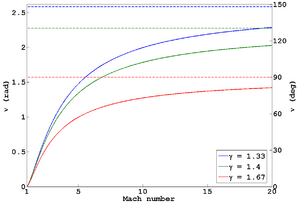Physics:Prandtl–Meyer function

In aerodynamics, the Prandtl–Meyer function describes the angle through which a flow turns isentropically from sonic velocity (M=1) to a Mach (M) number greater than 1. The maximum angle through which a sonic (M = 1) flow can be turned around a convex corner is calculated for M = [math]\displaystyle{ \infty }[/math]. For an ideal gas, it is expressed as follows,
- [math]\displaystyle{ \begin{align} \nu(M) & = \int \frac{\sqrt{M^2-1}}{1+\frac{\gamma -1}{2}M^2}\frac{\,dM}{M} \\[4pt] & = \sqrt{\frac{\gamma + 1}{\gamma -1}} \cdot \arctan \sqrt{\frac{\gamma -1}{\gamma +1} (M^2 -1)} - \arctan \sqrt{M^2 -1} \end{align} }[/math]
where [math]\displaystyle{ \nu \, }[/math] is the Prandtl–Meyer function, [math]\displaystyle{ M }[/math] is the Mach number of the flow and [math]\displaystyle{ \gamma }[/math] is the ratio of the specific heat capacities.
By convention, the constant of integration is selected such that [math]\displaystyle{ \nu(1) = 0. \, }[/math]
As Mach number varies from 1 to [math]\displaystyle{ \infty }[/math], [math]\displaystyle{ \nu \, }[/math] takes values from 0 to [math]\displaystyle{ \nu_\text{max} \, }[/math], where
- [math]\displaystyle{ \nu_\text{max} = \frac{\pi}{2} \bigg( \sqrt{\frac{\gamma+1}{\gamma-1}} -1 \bigg) }[/math]
| For isentropic expansion, | [math]\displaystyle{ \nu(M_2) = \nu(M_1) + \theta \, }[/math] |
| For isentropic compression, | [math]\displaystyle{ \nu(M_2) = \nu(M_1) - \theta \, }[/math] |
where, [math]\displaystyle{ \theta }[/math] is the absolute value of the angle through which the flow turns, [math]\displaystyle{ M }[/math] is the flow Mach number and the suffixes "1" and "2" denote the initial and final conditions respectively.
See also
- Gas dynamics
- Prandtl–Meyer expansion fan
References
- Liepmann, Hans W.; Roshko, A. (2001) [1957]. Elements of Gasdynamics. Dover Publications. ISBN 978-0-486-41963-3.
 |

